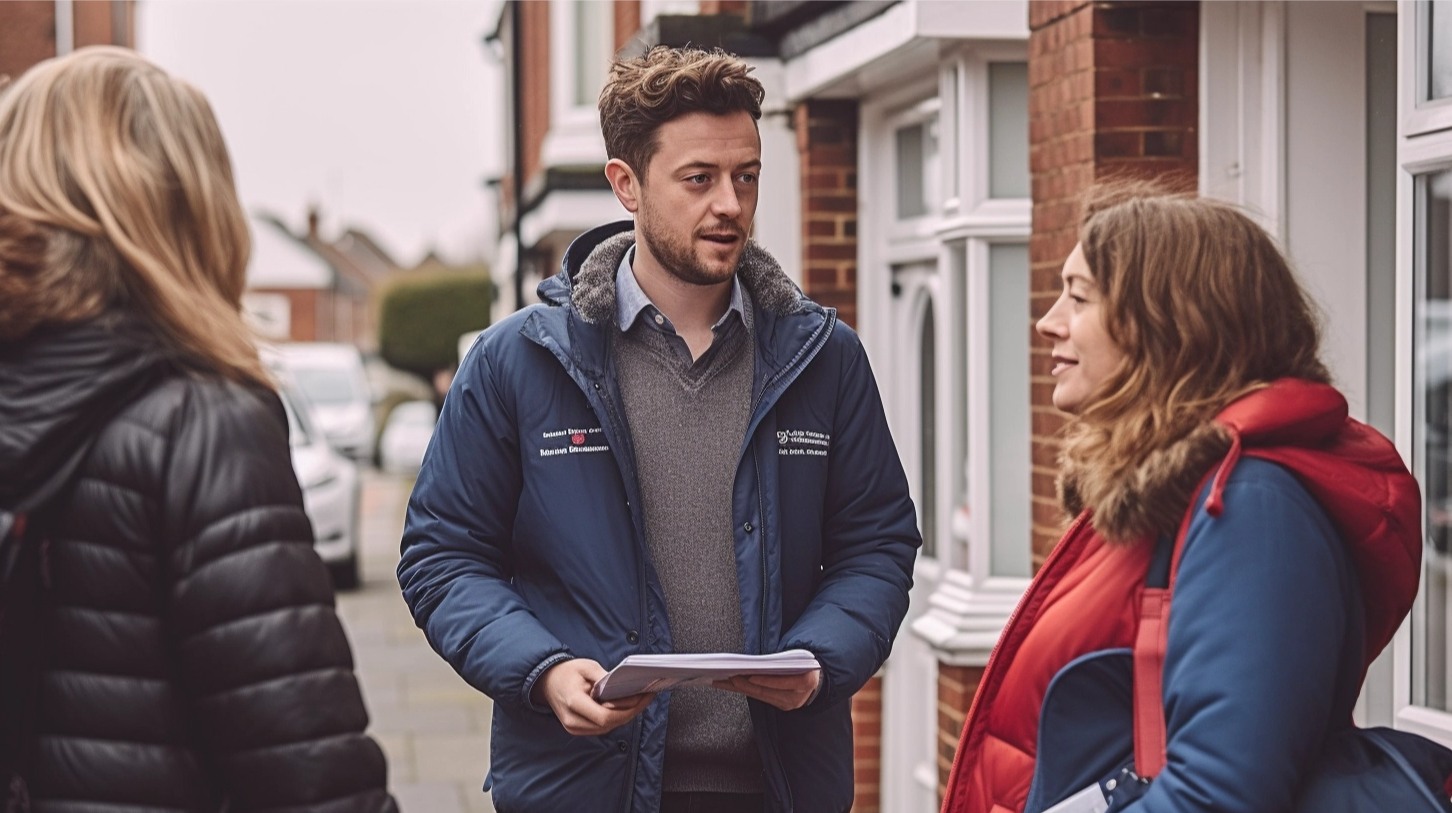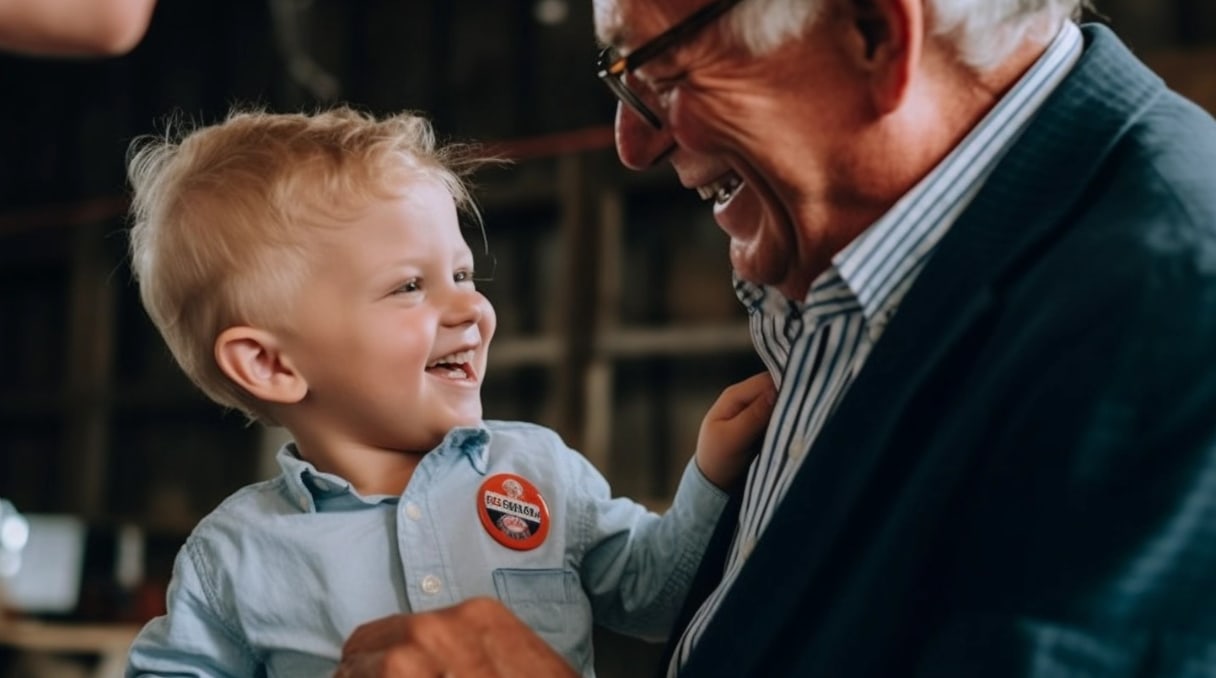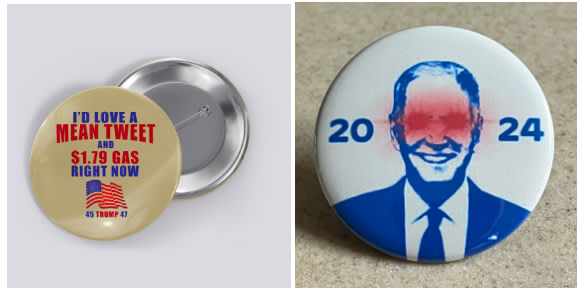Step-by-step campaign marketing guide using custom buttons
Sticker Mule द्वारा इस को पोस्ट किया गया
Do pin-back buttons win campaigns? Well, if you're looking to gain an edge for your campaign, they just might be the answer!
Campaign buttons are a quirky way to grab people's attention and they boost voter turnout. And if you get your messaging right, you might just end up creating an iconic piece of American history.
Their appeal is easy to understand. Pinback buttons are an easy, but subtle way to convey support for your politician of choice. Often, a person who would rather not flaunt their political allegiances in yard signs or car decals will still be open to the discrete, but firm political messaging that campaign buttons offer.
This, by the way, is key. If you're planning to add pinback buttons to your campaign swag items, it goes without saying you want to focus on your messaging. A campaign button may be a simple enough object, but if done well it is an amalgamation of your entire strategic planning. Let's find out how.
Step 1: Establishing the foundation: Identifying key issues and messaging
Your messaging is only as effective as the issues underlying it. This means to craft a powerful and compelling narrative, you will need a wide grasp of your voters' preferences: what they're happy and unhappy about, what they fear most, what impacts their day-to-day lives and well-being the most.
This, of course, is politics 101. But it's still worth emphasizing.
- Getting into the hearts and minds of people is what canvassing is all about:
- Going from door to door
- Getting to know the people who'll be (hopefully) electing you
- Finding out what matters to them.
This is also where you'll want to harness the power of polling. Polling is one of the most impactful political institutions brought to us by the last century. It's your best systematic tool for gauging preferences on a large scale and avoiding deadly biases, and should not be disregarded no matter whether you're running for state attorney, councilman, or even a seat in Congress.
Campaign pin-up buttons in practice
Want to see an example of proper political messaging? Look at Bill Clinton's 1992 campaign.
Take the issue in everyone's mind — the economy, as the US was in the midst of a recession. Polling amply confirmed that 82% of US voters found the economy to be either fairly or very bad. Then take the need to deliver a pithy, convincing message, and remember brevity is the soul of wit.
Mix all these ingredients and we get the famous slogan: "It's the economy, stupid."
That's the sort of message you aim for. Short, yes. But very, very well-planned.
Other prominent examples
Let's go over a few more historical instances, shall we?
- A message that seeks to inspire: The Obama "Hope and Change" slogan button
- A recovery promise: Reagan's "Let's Make America Great Again", repurposed and made famous by Trump's 2016 campaign
- A bit of humor: Nixon's "They Can't Lick Our Dick" campaign button (Yes, seriously.)
- And finally, a good apolitical example: Wendy's 80s "Where's The Beef?" button
Step 2: Creating impactful campaign buttons
So campaign buttons are essential to political messaging. Why? A few reasons.
- They're inexpensive
- Easy to produce
- Easy to wear
- They are a quiet way to express support
Plus, they're a great little thing to hand out in canvassing, in campaign committee meetings, or to friends and acquaintances.
Most importantly, they are a neat little mobile packaging of your political campaign: name, logo, voting date, slogan, and party colors. All of these can be combined to make the perfect campaign button.
Craft a button your grandson will want
Here's one thing to keep in mind when designing your campaign buttons: people like them because they're durable. Definitely more durable than your average election swag.
I mean, who keeps old election yard signs lying around? Not too many people I know of. Dirty, beaten down, worn off decals don't have that much of a life expectancy either. But a campaign button?
That, my friend, is a collectible. The best ones will pin themselves onto the fabric of American history, and be handed down for generations to come. Some will even make it into famous museum collections.
Step 3: Integrating buttons into canvassing
Campaign buttons can be a great device for your canvassing — and canvassing, as you know, plays a key role in election campaigns. Face-to-face interaction with voters will help you gain insights into their thinking, but it also makes you a more concrete person to them, increasing trust and familiarity.
In fact, canvassing is crucial not only for gaining and understanding voters, but as a core component of your get-out-the-vote strategy — that is, convincing your electors to do the irrational act of getting up and going to the ballot box for you.
This is why it's fundamental to train your canvassers on:
- Communicating a consistent message
- Active listening
- Compassion for voter’s lived experiences
- Extemporizing to connect with voters
You and your team can benefit from courses such as this master class on canvassing, on top of understanding basic voting psychology, voters' biases, and how to talk to voters.
Campaign buttons play well into canvassing, not only as a way for canvassers to identify themselves but also as a small gift to voters.
Step 4: Enhancing canvassing effectiveness
A few strategies go a long way to making your canvassing more effective. Make sure you provide proper training to new canvassers — above all, they should be familiar with good conversation practices.
Keep in mind that canvassing is a campaign all of its own, so it should have a clear objective — whether that is to acquaint yourself with new voters or to simply get them out to vote (GOTV).
You should also have a set script for canvassing conversations, including the line of argument to follow and answers to common voter questions. It's also a good idea to have your volunteers train among themselves, simulating conversations with voters and answering frequent points.
A practiced canvasser will also find ways to go beyond the script to drive home his or her point.
One way to do that is by sharing a personal story that ties in to the reason why it's important to vote, for example. Another, as mentioned above, is to leave a campaign button that both serves as a physical reminder of the visit — and a call to action, — and draws on the positivity that comes from receiving a gift.
Step 5: Data-driven canvassing optimization
To ace your canvassing game, you'll need a good plan for the several aspects you'll be tackling, such as:
- Managing your canvassing team
- Providing field reports and collecting insights
- Scheduling events
- Building and segmenting a contact database
For these and more, it can be a good idea to leverage the power of technology. There are plenty of software CRM targeting specifically this type of political activity, such as E-Canvasser or Mobilize.
A centralized platform will help keep track of the many different aspects a canvassing operation entails, allowing you to adjust your strategies based on the collected feedback and data insights.
In its turn, this feedback can be leveraged towards adapting or reformulating your campaign messaging, as well as refining the messages in your buttons and other campaign swag.
Step 6: Building social proof with button visibility
There is another way buttons support your campaign, and that is by building social proof for your campaign. Social proof — the phenomenon whereby people tend to mimic the behaviors of other members of their social sphere — can be leveraged through visibility and a sense of sharedness, and that's where buttons make their mark.
The simple act of wearing a badge, button, logoed t-shirt, or any symbol of some sort, can make a person feel more connected to the cause or institution associated with it. This, in turn, strengthens the perceived value of their membership and the actions associated with it. Which, in this case, is going out to vote.
With this in mind, you can distribute your campaign buttons at meetings or public events and have your canvassers wear them and carry some to give out to other contacts. As seen above, buttons carry a perception of value (a collectible, a nifty little token) that makes them an excellent giveaway for your campaign supporters.
Finally, don't forget the power of the Internet. Make sure your button-distributing campaign is well-represented on your main social media: sharing pictures of the buttons and people wearing them will make them seem more desirable and bring further visibility to your campaign.
Step 7: Microtargeting with customized buttons
Want to take the power of your button campaign even further? Consider targeting specific voter demographics and customizing your buttons accordingly.
How this could work is simple: - Once you have a large enough database on your electorate, you begin by segmenting according to relevant demographics — age bracket, minority groups, commitment to social or environmental causes, gender, and so on. That's something that should be par for the course in any campaign. - Next, brainstorm with your team and come up with different button designs that appeal to different demographics. Ideally, you'll be able to bring to button form the different causes your campaign is committed to, whether that's individual rights or environmentalism. - Finally, remember to style your buttons according to the groups they're targeted for. Millennials might appreciate a more minimalistic design whereas a baby boomer would like a more classic style. (Never mind Generation X, they're all online.)
To distribute these targeted buttons, leverage the power of your databases (hopefully you are building a good one with the right platform) to determine where to distribute which — whether that's in train station gatherings, town hall meetings, or good old door-to-door knocking.
Step 8: Continuous strategy evaluation and adjustment
It's hard to get things right the first time, so be sure to give yourself space to experiment with different ideas and adjust as the feedback comes in.
Remember to be organized with your A/B testing — that is, testing how two or more sets of parallel ideas work with different groups, and drawing actionable conclusions from the results. This can be used for your general campaign messaging, but also for specificities such as your campaign swag: distribute different batches of buttons and other campaign swag to different canvasser teams, keeping a record on how these are received. This will help you orient going forward.
As with anything else, the secret to success is observing and adapting, even if that means never getting out of a constant improvement loop.
Step 9: Integrating buttons with overall campaign strategy
Your campaign buttons are all the better if they tie in with the rest of your campaign strategy. This means you should:
- Retain messaging consistency throughout your campaign swag, online marketing materials, etc.
- Pair your pin-up button with your campaign's overall visual themes
- Seek to integrate your buttons with other parts of your campaign.
For this last point, think social media themes, popular moments in the campaign, and even memes that arise during the campaign — all of these provide good opportunities to up your campaign badge game.
Recent case in point: two pins for the 2024 election (see below). One is pro-Trump, one is pro-Biden. Both reflect a good dose of self-aware humor, with one playing on Trump's famous social media presence and the other rolling with the "Dark Brandon" meme that was even embraced by the President himself.
These are just a couple of examples, but the potential for integrating your pin-back buttons with the social media environment is virtually (no pun intended) limitless. You can simply go online, find what light your campaign is being portrayed in, the memes about it, etc., and take your ideas from there.
Before you know it, you'll have a campaign button worth speaking of!
Step 10: Post-campaign reflection and learning
Once the campaign is over, it's time to reflect and summarize what you learned from it. That's regardless of the result. Whether a bitter defeat or a resounding victory, this campaign is unlikely to be the last. And in today's fast-shifting environment, drawing the right conclusions can give you the edge you need for the next time around.
There is no lack of tools here, either. You'll want to compare survey data to actual results, gather insights from advisers and campaign collaborators, and — very importantly — keep in touch with your voters and maintain a tight database of the contacts made along the way.
Conclusion
Ultimately, the success of political campaigns hinges on a wide variety of factors. Current societal trends, how effective your team is, how effective the opposition is, the value of your campaign promises. And so on.
Some of these things may be outside of your control. But key ones aren't. You can always improve your strategy, up the vigor of your campaign, and boost the enthusiasm of your followers. These things are malleable and, to no small extent, willpower-driven.
So be proactive. Think of all the ways you could be improving the way you move your campaign marketing forward. And don't forget to leverage the historically-proven power of campaign buttons to drive your point home, pin it, and make it something to remember.






